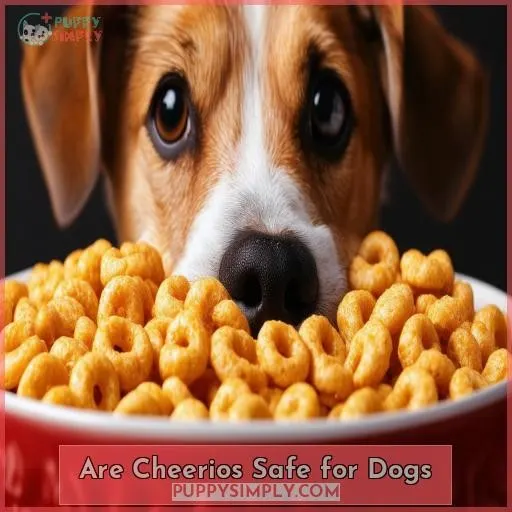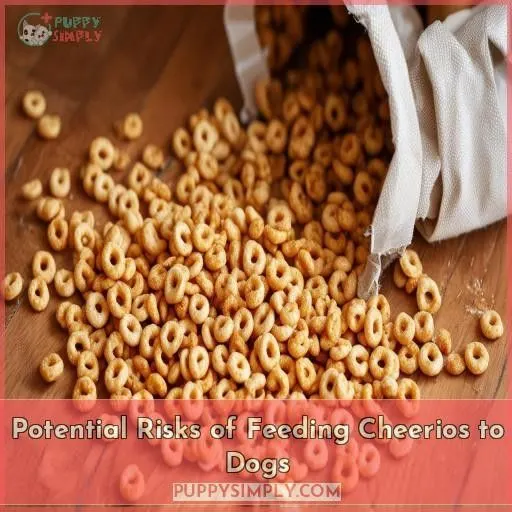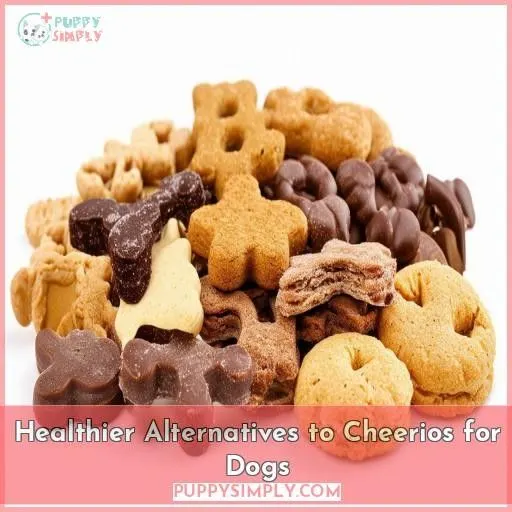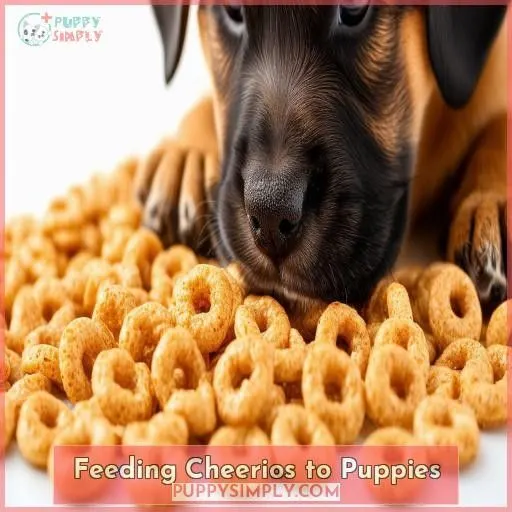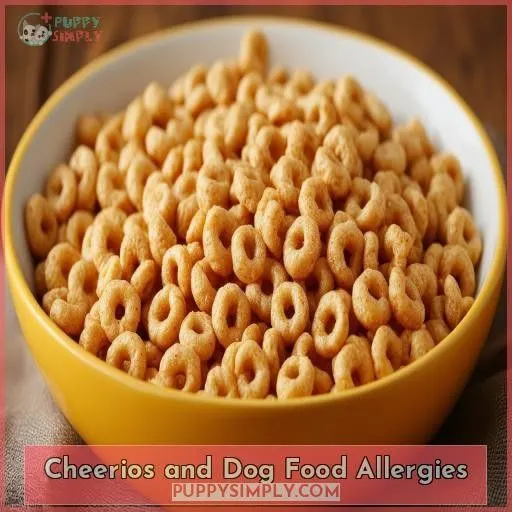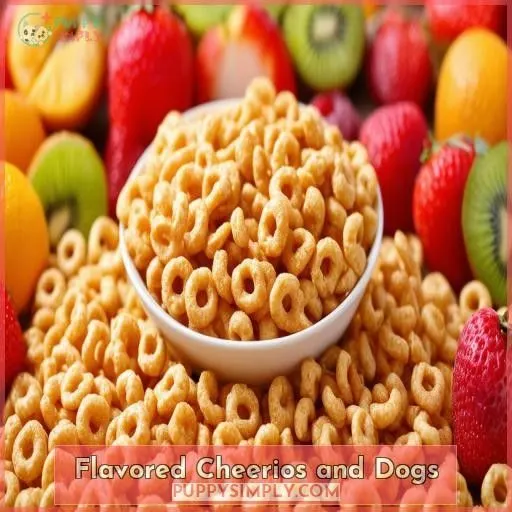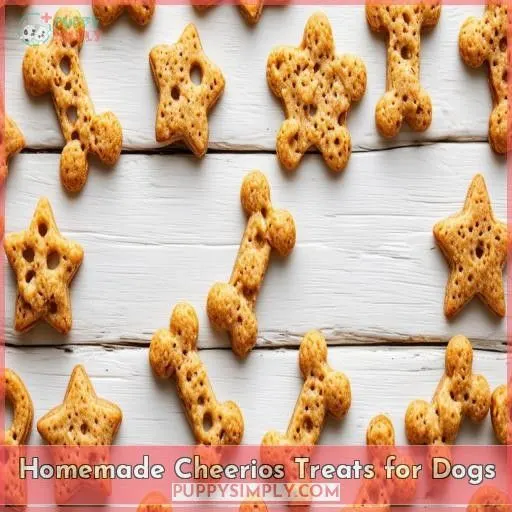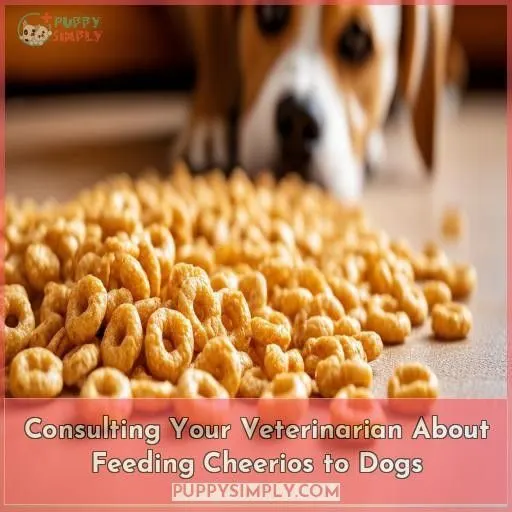This site is supported by our readers. We may earn a commission, at no cost to you, if you purchase through links.
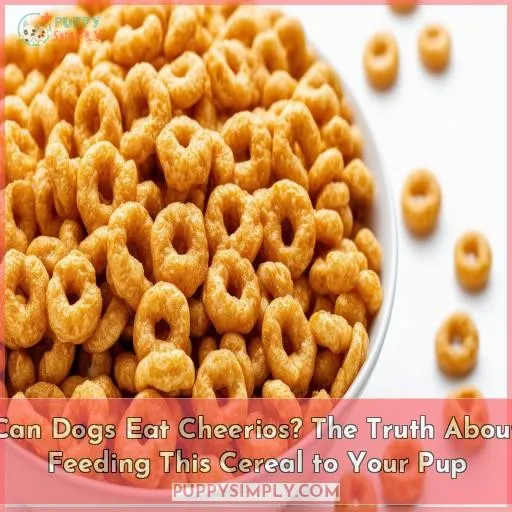
Feeding Cheerios in moderation, like an occasional treat, is fine, but they shouldn’t replace more balanced dog treats. Dogs might face issues like digestive upset or dental problems if they munch too many.
Healthier alternatives include dog-safe fruits and veggies, freeze-dried meats, or homemade treats like boiled chicken.
Curious about the best treats for your furry friend? Keep going to discover the healthiest options!
Table Of Contents
- Key Takeaways
- Can Dogs Eat Cherios?
- Are Cheerios Safe for Dogs
- Potential Risks of Feeding Cheerios to Dogs
- Healthier Alternatives to Cheerios for Dogs
- Feeding Cheerios to Puppies
- Cheerios and Dog Food Allergies
- Portion Control When Feeding Cheerios to Dogs
- Cheerios and Dog Dental Health
- Flavored Cheerios and Dogs
- Homemade Cheerios Treats for Dogs
- Consulting Your Veterinarian About Feeding Cheerios to Dogs
- Frequently Asked Questions (FAQs)
- Conclusion
Key Takeaways
- Cheerios are like junk food for dogs – low in nutrients, high in empty calories.
- While not toxic, too many Cheerios can lead to weight gain and digestive issues.
- Better treat options include dog-safe fruits, veggies, and lean protein.
- If you do give your dog Cheerios, keep it to a small amount and opt for the plain variety.
Can Dogs Eat Cherios?
Yes, dogs can eat Cheerios, but they offer minimal nutritional value and should be fed only as occasional treats . Always opt for plain, unflavored Cheerios, as flavors like Honey Nut or Chocolate can be harmful (Source).
Are Cheerios Safe for Dogs
While Cheerios aren’t toxic to dogs, they lack nutritional value and should only be given as an occasional treat in moderation. Cheerios are high in carbohydrates and low in protein, so feeding them excessively can lead to weight gain and other health issues in dogs.
Cheerios Are Not Toxic to Dogs
While Cheerios aren’t toxic for your pup, they’re not really nutritious either. Think of them as empty calories – sure, your dog will probably enjoy their crunchy sweetness, but they’re high in sugar and salt with no real benefits. If using as treats, be mindful of portion sizes to avoid weight gain or tummy troubles.
Cheerios Lack Nutritional Value for Dogs
While Cheerios aren’t toxic, they’re fundamentally empty calories for your dog. These whole grain Os:
- Lack protein
- Are high in carbs
- Offer little nutritional value
Your pup’s digestive system isn’t designed to process grains efficiently. So while the occasional Cheerio won’t harm them, their diet should consist of quality proteins and dog-specific nutrients.
Cheerios Should Be Fed in Moderation as Treats
While you can give your pup a few Cheerios here and there, they should only be an occasional treat. Cheerios lack nutrients dogs need, so feeding too many just adds empty calories that could lead to weight gain. Stick to healthy, dog-approved snacks like carrots or lean proteins as their go-to rewards.
Potential Risks of Feeding Cheerios to Dogs
While Cheerios are generally safe for dogs to consume in moderation, you should be mindful of their high carbohydrate and low protein content, as excessive amounts can contribute to weight gain and obesity. Additionally, some dogs may experience digestive upset after eating Cheerios, so it’s important to introduce them gradually and monitor your pup’s reaction.
Cheerios Are High in Carbohydrates and Low in Protein
While Cheerios aren’t toxic, their high carbohydrate content and lack of protein make them unsuitable as a primary dog food. Here are four key concerns:
- Carb overload can strain your pup’s carbohydrate metabolism.
- Their low protein levels fail to meet your dog’s dietary needs.
- Whole grain corn offers little nutritional value for dogs.
- Feeding too many Cheerios risks digestive sensitivity and dental issues.
Moderation is key when offering Cheerios as an occasional treat.
Excessive Cheerios Can Lead to Weight Gain and Obesity
If your pup overeats Cheerios, they’ll pack on the pounds. These carb-heavy treats lack protein, making them calorically dense. Excessive weight gain raises diabetic risks and impacts cardiovascular health. To avoid obesity-related issues, portion control with Cheerios is imperative for proper weight management.
Cheerios May Cause Digestive Upset in Some Dogs
While Cheerios aren’t toxic, they may trigger digestive issues like:
- Diarrhea and vomiting from the high carb content
- Allergic reactions in sensitive dogs
- General stomach upset and gas
Replace Cheerios with safe fruits and veggies for treats. If your pup develops symptoms after eating them, discontinue feeding Cheerios immediately.
Healthier Alternatives to Cheerios for Dogs
Instead of feeding your dog Cheerios, consider offering dog-safe fruits and veggies like carrots, green beans, or apple slices as healthier treat options. Your vet can also recommend low-calorie, high-protein dog treats designed specifically for your pup’s nutritional needs.
Offer Dog-safe Fruits and Vegetables as Treats
Instead of sugary Cheerios, offer your dog safe fruits and veggies as treats. These nutritious snacks provide fiber, vitamins, and antioxidants. Check this 3×3 table for ideas:
| Safe Fruits | Safe Veggies | Unsafe Foods |
|---|---|---|
| Apples | Carrots | Onions |
| Bananas | Green Beans | Grapes |
| Blueberries | Sweet Potato | Raisins |
Moderating unhealthy snacks is essential for your pup’s wellbeing.
Choose Low-calorie, High-protein Dog Treats
Instead, you should choose low-calorie, high-protein dog treats. These include:
- Freeze-dried meat
- Jerky strips
- Dental chews
For homemade options, consider boiled chicken or pumpkin treats. Consult your vet for diet suggestions customized to your pup’s needs.
Consult Your Veterinarian for Personalized Treat Recommendations
For the best cereal alternatives and personalized treat advice, consult your vet. They’ll consider your pup’s age, size, activity level, and any health conditions to recommend appropriate treat frequency and options that double as behavioral rewards and dental chews. Your vet’s expertise guarantees your furry friend’s treats are both enjoyable and beneficial.
Feeding Cheerios to Puppies
Puppies have specific nutritional needs that are different from adult dogs, so while Cheerios may be an occasional treat for grown pups, they shouldn’t replace a balanced puppy diet. To make certain proper growth and development, it’s best to stick to puppy-formulated treats and foods recommended by your veterinarian.
Puppies Have Different Nutritional Needs Than Adult Dogs
Unlike adult dogs, puppies need specialized diets to support their rapid growth and development. Their nutritional needs are different, so you should avoid giving them too many Cheerios. Here are some key points:
- Puppies require higher protein and calorie intake
- Cheerios are low in protein and lack essential nutrients
- Excessive carbs from Cheerios can lead to obesity
While an occasional Cheerio is fine, focus on providing a complete and balanced puppy food to meet their unique dietary needs. Consult your vet for healthy puppy treat recommendations.
Stick to Puppy-specific Treats and Food
Regarding puppies, avoid Cheerios and choose treats designed specifically for them.
A growing puppy has unique nutritional needs compared to an adult dog. It’s essential to feed them appropriate snacks and food.
Consult with your veterinarian about safe treat options that meet your pup’s dietary requirements.
Homemade treats are an excellent way to guarantee that your furry companion receives the nutrients they need. They also minimize potential food allergies or digestive problems caused by human snacks like Cheerios.
Cheerios and Dog Food Allergies
Before introducing Cheerios or any new treats to your dog’s diet, it’s essential to consult with your veterinarian. This is especially important if your furry friend has known food allergies or sensitivities.
Additionally, monitor your pup closely for signs of an allergic reaction after consuming Cheerios. Such signs include excessive scratching, digestive issues, or breathing difficulties. If any concerning symptoms arise, discontinue feeding them Cheerios immediately.
Consult Your Veterinarian Before Introducing New Treats
Before introducing Cheerios or any new treats, it’s essential to consult your veterinarian. They can:
- Evaluate your dog’s dietary needs
- Assess potential food allergies
- Recommend portion sizes
Even if Cheerios seem harmless, your vet understands your pup’s nutritional value requirements and can identify foods that may cause digestive upset. With expert guidance, you’ll guarantee your furry friend stays happy and healthy while enjoying an occasional Cheerio treat in moderation.
Monitor Your Dog for Signs of Allergic Reactions
If you decide to give your pup Cheerios as treats, keep a watchful eye out for any allergic reactions.
Look for signs like skin rashes, excessive scratching, sneezing, watery eyes, or hives. If you notice these symptoms after introducing Cheerios, it’s best to stop feeding them and consult your vet.
Every dog is unique, so monitor closely for any adverse reactions to guarantee your furry friend’s well-being.
Portion Control When Feeding Cheerios to Dogs
Portion control is very important when feeding Cheerios to your pup. While an occasional treat is fine, overeating can lead to weight gain. Here are some tips:
- Limit Cheerios to 10% of your dog’s daily calorie intake
- Give no more than 1/4 cup per 20 lbs of body weight
- Opt for healthier alternatives like carrots or low-fat treats
Cheerios and Dog Dental Health
While Cheerios aren’t toxic for dogs, they don’t provide any dental benefits. In fact, their crunchy texture can contribute to dental plaque buildup and potentially lead to dental caries (cavities) if fed excessively. Consider making your own homemade Cheerios treats with dog-friendly ingredients to reduce the risk of dental issues.
| Ingredient | Quantity |
|---|---|
| Plain Cheerios | 1 cup |
| Peanut Butter | 1/4 cup |
| Rolled Oats | 1/2 cup |
Mix ingredients, roll into balls, and bake for a healthier crunchy treat.
Flavored Cheerios and Dogs
You should avoid feeding your dog flavored varieties of Cheerios, such as Honey Nut or Chocolate Cheerios. The honey and chocolate used to flavor these cereal varieties can be toxic to dogs, potentially causing serious health issues.
Avoid Flavored Cheerios, Such as Honey Nut or Chocolate
While plain Cheerios can be an occasional treat, you’ll want to avoid giving your pup honey nut or chocolate varieties. These flavored Cheerios contain ingredients like honey, chocolate, and nuts that could potentially harm your dog. For your furry friend’s safety, stick to unflavored, plain Cheerios as an infrequent snack.
Honey and Chocolate Can Be Toxic to Dogs
You’ll want to avoid giving your pup flavored Cheerios like Honey Nut or Chocolate varieties. The honey in those can cause gastrointestinal upset and severe diarrhea in dogs. More concerning, the chocolate is toxic and potentially life-threatening if consumed. Almonds in Honey Nut Cheerios may also trigger digestive issues.
Stick to Plain, Unflavored Cheerios if Feeding as Treats
If feeding Cheerios as treats, stick to the plain, unflavored variety. Flavored options like Honey Nut or Chocolate Cheerios contain ingredients that can be toxic for dogs like honey and chocolate. For safe puppy snacks or homemade dog treats, opt for unflavored Cheerios and dog-safe add-ins. As always, consult your vet for personalized advice on occasional Cheerio treats.
Homemade Cheerios Treats for Dogs
You can create your own homemade Cheerios treats for your dog by using plain, unflavored Cheerios and mixing them with other dog-safe ingredients. Doing so allows you to control the ingredients and provide a healthier, more nutritious treat option for your furry friend.
You Can Make Your Own Cheerios Treats at Home
If you’d like to offer your pup homemade Cheerio treats, it’s easy to make them yourself.
Bake plain Cheerios with dog-safe ingredients like peanut butter, honey, or mashed bananas.
This allows you to control the ingredients and avoid potential allergens.
Just be sure to check for any allergies your dog may have before making homemade Cheerio treats.
With a little creativity, you can create tasty, pup-approved snacks!
Use Plain, Unflavored Cheerios and Add Dog-safe Ingredients
If you opt for homemade Cheerios treats for your pup, use only plain, unflavored Cheerios. Add dog-friendly ingredients like:
- Peanut butter (xylitol-free)
- Shredded carrots
- Mashed banana
- Rolled oats
Combining Cheerios with these nutritious ingredients creates tasty, crunchy snacks packed with fiber and vitamins. DIY treats allow you to control portions and monitor your dog’s snack intake while providing an occasional indulgence. Be mindful of your canine companion’s nutrition needs and offer these homemade treats in moderation.
Consulting Your Veterinarian About Feeding Cheerios to Dogs
You know your pup better than anyone, but it’s always prudent to consult your vet before introducing new treats like Cheerios.
They can advise on the appropriate portion size, any potential risks based on your dog’s health history, and whether homemade Cheerios treats could be a tasty, low-calorie option.
Ultimately, your vet’s guidance guarantees you’re keeping your furry friend’s nutritional needs and dental health in tip-top shape.
Frequently Asked Questions (FAQs)
Is it safe for dogs to eat Cheerios?
Yes, dogs can eat Cheerios, but they’re not ideal. Think of them as candy: safe in tiny amounts, harmful in excess due to added sugar and salt. Prefer healthier, vet-approved treats for better nutrition and safety.
What cereals are safe for dogs?
You can safely give your dog plain cereals like bran flakes or wheat-based cereals in moderation. Avoid sugary, chocolate-covered, or artificially sweetened cereals, as they can be harmful and lead to health issues (Source).
Is oatmeal good for dogs?
Yes, oatmeal is good for dogs. It’s a nutritious, fiber-rich option, supports digestive health, and is beneficial for dogs with wheat allergies, when served plain and cooked. Always consult your vet for personalized advice .
Can dogs eat special K?
Your excitement about Special K for your dog is commendable, but you should know it’s not ideal. While the occasional piece won’t harm, its sugary nature and questionable ingredients contribute to empty calories without nutritional benefits (Source).
Can dogs eat Cheerios with milk?
Dogs can eat Cheerios in small amounts, but avoid adding milk. Milk can cause gastrointestinal upset due to lactose intolerance in many dogs. Stick to offering Cheerios as an occasional, dry treat instead .
Do dogs prefer Cheerios over other dog treats?
Dogs generally prefer savory and meaty treats over Cheerios. Cheerios, being low in nutritional value and primarily filler, don’t match the taste and benefits of traditional dog treats [e.g., citation:3].
Can Cheerios be used in dog training?
Cheerios can be used in dog training sparingly as a low-value treat, especially in food puzzles to keep your dog engaged. However, they offer no nutritional benefits and shouldn’t replace high-quality training treats .
Are Cheerios safe for dogs with sensitive stomachs?
Better safe than sorry, Cheerios aren’t advisable for dogs with sensitive stomachs. They lack essential nutrients and might exacerbate issues due to added sugars and salts, risking further gastrointestinal distress .
Conclusion
Ultimately, while dogs can eat Cheerios, they’re not the healthiest option. These cereals aren’t toxic but lack nutritional value and can lead to issues like weight gain and digestive upset if given in excess.
For more balanced choices, opt for dog-safe fruits, vegetables, or low-calorie, high-protein treats. Always consult your veterinarian before introducing new foods to your pup’s diet to guarantee their well-being.
Stick to plain Cheerios if you decide to use them as an occasional treat.

